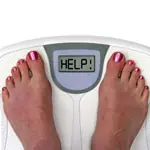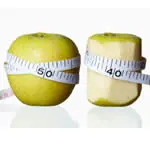Portion Distortion
Choose satisfied over stuffed. The sizes of your portions affect how many calories you're getting. Double the amount of food equals double the number of calories. Most Americans underestimate how much they're eating, especially when dining out. Always plate your food. Eating out of the box or bag gives you no sense of what or how you are eating. Serve foods with measuring cups, or spoons to see how much you are actually eating. The average woman, with moderate daily exercise should be consuming approximately 3 to 4 oz. of lean protein per meal, half to 1 cup of whole grains per meal, and 1 to 2 cups of brightly colored fruits and vegetables per meal.
Eat Fiber
Fiber comes from plants, particularly legumes, fruits, vegetables, and whole grains. Foods which are high in fiber are usually low in calories. More of these types of foods can be eaten without consuming too many calories. Fiber rich foods can be quite satisfying. They need a longer amount of time to break down. Fiber slows the rate of digestion helping us feel full longer. Aim for 25 to 50 grams of fiber rich foods daily. Be sure to balance the intake of the soluble and insoluble forms (i.e. fruits, vegetables and whole grains.)
Snack
Although snacks are part of a healthy diet, they can become a source of extra calories. Always keep moderation in mind. The goal for snacking is to limit snacks to 150 to 200 calories. Always include the three macronutrients: protein, fat, and carbohydrate. Always understand the ingredients, avoiding anything artificial or refined.
Small meals consumed approximately every three hours can contribute to stable blood sugars throughout the day. Choose treats that are high in fiber (5 grams or more per serving) such as, bean dips, fruits and vegetables with peanut butter or hummus, and low-fat dairy. Choose whole grains that have a low glycemic index and include a small amount of protein with them to keep your cravings in check.
Sleep Enough
According to the National Sleep Foundation, 63 percent of American adults are not getting the recommended eight hours of sleep a night. When afternoon hits, most people are confusing fatigue with hunger. The trip to the vending machine is justified. These foods do make us feel better, because they quickly raise blood sugar due to the large amount of saturated fat and refined carbohydrates. Poor sleep quality and sleep deprivation can elevate levels of ghrelin, which is our appetite-stimulating hormone, and lower levels of leptin, our appetite-suppressant hormone. As a result, we take in more calories throughout the day leading to ultimate weight gain.
Exercise
The key to successful weight loss and improved overall health is making physical activity a part of your daily routine. The key to weight control is balancing your intake with expenditure. Exercise along with cutting calories helps to improve your weight loss. A 2011 JAMA article shows that approximately 150 to 200 minutes of exercise each week regardless of duration or intensity may result in weight loss.
Chrissy Wellington is co-author of Navigating the Supermarket: A Nutritious Guide to Shopping Well. To pick up a copy of her book, please visit willpowermatrix.com/public/120.cfm.
- 2
- of
- 2








Discuss This Article